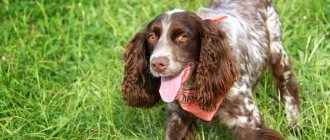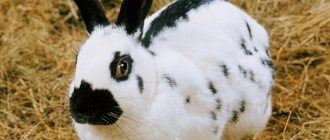Breed characteristics
| Short description | |
| Origin: | France, Belgium |
| Conditions of detention: | House, apartment |
| Purpose: | Decorative dog and companion dog |
| Color: | White with spots of various colors (except blue), black with tan |
| Wool length: | Long |
| Adult dog size: | Height – 28 cm, weight – 1.5-5 kg |
| Average life expectancy: | 14-18 years old |
| Walk: | Need two walks a day |
| Physical activity needs: | Average physical activity needs (walking 1 to 3 hours per day) |
| Fédération Cynologique Internationale (FIC) classification: | Group 9: decorative and companion dogs; Section 9: Continental Toy Spaniel and Russian Toy |
| Puppy price: | From 12,000 to 80,000 rubles. Without pedigree - 12,000-15,000 rubles, pet class - 20,000-30,000 rubles, breed class - 40,000-60,000 rubles, show class - 70,000-80,000 rubles |
Nutrition
Mini spaniels are always surprisingly active, so they spend a lot of energy, which is replenished with high-calorie, quickly digestible food. When feeding puppies and adults, important rules should be followed:
- if the diet is dominated by purchased food, then the dog should have constant access to fresh and clean water;
- Along with food, the body receives beneficial vitamins and minerals, so the diet should be filled with these elements as much as possible;
- It is recommended to feed the baby only with warm foods;
- food from the master's table is taboo for spaniels;
- The Papillon digestive system does not digest raw meat well, so it is combined with vegetables;
- It is recommended to check your weight monthly to understand when you need to make changes to your diet;
- After eating, the dog should be given 20-30 minutes of rest, and should be taken for a walk after a while;
- food is selected carefully; preference should be given to high-quality varieties suitable for mini dogs.
Expert opinion
Anna Abramenko
An avid dog lover. Experience in veterinary medicine since 2009.
Ask a Question
During the summer heat, children's activity decreases, so the portion size decreases, but more water is needed.
History of the origin of the species
The Papillon is a French breed, as evidenced by the name itself, which is translated from French as “butterfly”. Dog handlers are inclined to believe that the closest relatives of these dogs are dwarf spaniels, which is why the breed has a second name - Continental Toy Spaniel.
There is still no exact time when the breed was bred . About 800-1000 years ago, the first similar dogs appeared in the paintings of artists, such as Titian (“Roberto Strozzi’s Daughter”). In addition, they were depicted in portraits of nobles and royalty. Papillons were the favorites of Marie Antoinette, Henry II, Louis XIV, and the Marquise de Pompadour. Kings spent fabulous sums so that a cute dog could share moments of joy and sadness with them.
After the French Revolution, Continental Spaniels were destroyed as a symbol of the bourgeoisie. Therefore, the breed almost became extinct, but was restored in the 18th and 19th centuries.
In the 20s of the 20th century, dog breeders and cynologists crossed the breed with Spitz. Thanks to this work, the spaniels' coat has improved and acquired a new silky appearance. In 1934, the first standard was approved, after which Papillons spread throughout the world.
Cost of Papillons
If you decide to get this breed, then get ready for significant expenses. Papillon puppies are quite expensive. On average, such a baby will cost from thirty to fifty thousand rubles. And if the puppy has titled relatives in the family, then the price tag can reach up to seventy thousand.
If you just need a friend for your soul and company, with whom you are not going to attend exhibitions, participate in competitions, or engage in breeding, then you can count on a smaller amount. A Papillon with a Plembrak costs from ten to fifteen thousand rubles. This does not mean that the puppy will be sick. He may have external defects that simply do not allow him to fit into the breed standard.
Distinctive features
A truly royal dog with graceful movements and a slightly arrogant appearance. Papillons are distinguished by their elongated body format, pointed muzzle, long hair and small size. As a rule, both males and females reach 28 cm , but they weigh differently: from 1.5 kg to 5 kg.
The standard distinguishes between two types of Continental Spaniels: Papillon (butterfly ears - erect) and Phalene (dropping ears). In all other respects, both subspecies are almost the same. However, crossing them is prohibited because the puppies end up with semi-erect ears.
- The head is small, light, but proportional to the body. The skull is not too round, the furrow between the eyes is visible. Stop is expressed.
- The muzzle is short, narrowed, the bridge of the nose is straight. Cheekbones are filled, cheeks are flat. The jaws are strong with a scissor bite. Thin lips pressed to the jaws.
- The nose is small and round.
- The eyes are large, almond-shaped; set low and wide. The inner corner of the eye is in line with the stop. The color is dark brown, the eyelid is pigmented.
- Ears . Papillon : ears stand on hard cartilage, set high, rounded at the tips, set at 45° to the horizon, covered with thick flowing hair. Phalene : Ears are set high, drooping and close to the head, surrounded by thick, flowing hair.
- The body is more elongated than square. The topline is straight, the back is strong and short. The loin is rounded, the croup is not sloping. The chest is wide and deep with rounded ribs. The belly is well tucked. The neck is curved, of medium length.
- The tail is high set, quite long, carried over the hip or lower back, but does not form a ring. Surrounded by long hair that forms a fountain.
- The limbs are set parallel and straight. Quite strong and muscular. The paws are long, like a hare's. The fingers are well developed and mobile. The movements are graceful, proud, light.
- The coat is wavy, thin, flowing and shiny. Quite thick, no undercoat. The hair is short on the body and head, frilled on the neck, and elongated on the ears and tail. Feathering on the limbs is characteristic.
- The color is white with spots of any color. The head should always be dark.
Tips for choosing puppies
If you want to be sure of the health and purity of the blood of a new family member, then choose trusted breeders and well-known specialized nurseries. They have extensive experience in breeding the breed. Before picking up a puppy, read the documents for him and his parents. In Russia today there are several alternative cynological organizations. But, nevertheless, the metric from RKF is valued more highly. You can also study your baby’s veterinary passport. It will be good if you take the dog with vaccinations already completed according to age.
Be sure to check if your dog has hearing problems. To do this, clap your hands loudly. If the dog’s health is fine, then he will definitely react to a sudden loud sound.
Once you are sure that the documents meet your requirements, evaluate the appearance of the Papillon. His coat should be shiny, his eyes and ears should be clean. The puppy himself should be interested in everything that happens around him. It’s bad if the animal is lethargic, afraid of loud sounds, or afraid to approach you. The dog should not show aggression. Please note that he should not have dewclaws, and there should be a mark on his body. A swollen belly may indicate that the dog has gastrointestinal problems or has helminths.
In some cases, testing for compliance with breed standards in Papillons can be difficult. This is due to the fact that many puppies mature unevenly. In this case, it is better to seek help from a specialist who will help you understand this issue. Or give preference to already grown up teenage puppies.
Photo of an adult dog
Interesting facts from the life of dogs
- France is considered the birthplace of the miniature spaniel.
- The pet's height does not exceed 27 cm.
- Despite their jealousy, they get along well with other pets.
- The dog is filled with energy, which it splashes out through long games and learning about the world around it. While walking, she hunts for butterflies, grasshoppers, and mice.
- When frightened, a Papillon may bite, but proper training eliminates this drawback.
- Black and red wool is much drier than other shades, so it needs to be periodically moistened with special products.
- Without attention from the owner, puppies and adults become irritable. But walks in the fresh air with an abundance of active games can bring your psycho-emotional state back to normal.
Photos of puppies
Features of character and behavior
It is worth noting that this breed is one of the smartest on the planet (ranked 8th). Therefore, Papillons are easy to train and raise. Dog breeders claim that such spaniels are bundles of energy, perpetual motion machines - optimistic and active. Pets become real friends for children and adults. They are very playful and cheerful; it is rare to meet a sad or dissatisfied spaniel. However, it is still a dog.
The Papillon has a sense of self-esteem and is prone to dominance and manipulation. Without proper training and socialization, such a cute dog can become aggressive and uncontrollable.
Advantages
- Continental Toy Spaniels are loyal and devoted dogs who will never trade their family or run away. They are attached to the owner and household members, love children and can protect them with loud barking.
- Despite its small size, this dog’s guard instincts are well developed.
- Many breeders claim that Papillons easily make friends with other pets.
- They are playful, active and optimistic . An activity can be found anywhere and at any time.
- The positive side is independence; most often the spaniel does not need anyone to play with, although he will not refuse to run after a ball or stick.
- They are inquisitive and very smart, they sense the mood of the owner. These dogs can support you in difficult times, calm you down and cheer you up. They will not impose themselves, but attracting people’s attention is one of the main tasks of such a pet.
Flaws
- They require training and education. Papillons have a multifaceted character. They can become aggressive and angry without proper socialization in a timely manner. Cute puppies love to sit on the neck and manipulate the owner, often occupying the position of leader in the house.
- They cannot stand loneliness. Such a pet cannot be left at home for a long time. He will start whining and moping in boredom. Therefore, this breed is not suitable for constantly working and busy people.
- Touchy and vindictive. Continental Spaniels will remember everything that they didn’t like during training or communication and are unlikely to forgive someone who once harmed them.
Training and education
The dog quickly learns new commands, as it has a high intelligence and has an inquisitive disposition.
You should start raising a butterfly dog as a puppy, since the breed has a rather perky and restless character. In addition, the lively and inquisitive mind of a pet constantly needs to be nourished with new knowledge. The animal will definitely want to immediately test the information received in practice.
If you spend enough time raising your pet from a young age, then it will be easy to train. Despite their external fragility, Papillons can withstand heavy loads both mentally and physically. When training your pet, you should adhere to the following rules:
- Commands must be given in an even, serious and stern voice. Under no circumstances should you shout or make sharp attacks towards your pet, or vice versa, lisp and play with it.
- If the dog quickly grasps new information and shows commands correctly, you should treat it with its favorite dog treat.
- You shouldn’t punish Papillon dogs too much, as they are very vulnerable animals that react very sensitively to rudeness.
Care and maintenance
Caring for a Papillon is no more difficult than caring for any decorative dog. They shed twice a year, so taking care of a clean, beautiful coat is a priority on the list of procedures. To do this, you need to comb the dogs, bathe them in a timely manner and cut their hair (if they are not participating in exhibitions).
Continental Toy Spaniels are suitable for domestic life only. Street maintenance is impossible not only because of its miniature size. This breed does not have an undercoat, so the dogs get cold in winter and can overheat in summer. Such small animals can be kept in an apartment; the Papillon does not need a lot of space. He can adapt to a home toilet, but this will not be a full replacement for walking.
- After changing teeth, you need to brush your incisors every two weeks with a soft brush and special toothpaste. Chewing cords can be used.
- Claws are trimmed with a nail clipper once every 2-3 weeks.
- Eyes and ears are examined daily. Cleaning the ears is not a frequent procedure ( 3-4 times a month), but the eyes should be washed with chamomile decoction every 5-6 days.
- Before buying a puppy, you need to equip the house, purchase the necessary items for daily use: a bed, brushes and combs, hygiene products, toys, bowls on adjustable stands. Usually such miniature dogs sleep with their owners, but it is better not to accustom them to this.
Nutrition
Papillons are small dogs, so feeding them will not be expensive. If the breeder advises feeding the puppy the same thing that he was fed in the kennel, then you should listen. Otherwise, the transition to another food should be smooth.
- Increasingly, dog breeders prefer dry feeding. It is easy to use and contains a complex of essential vitamins and minerals.
- You need to choose holistic (grain-free) super-premium for small, active breeds.
- In case of allergic reactions, you need to subtract the composition and change the product to a hypoallergenic one.
- Typically, an adult Papillon needs 200-300 grams of dry food per day. It needs to be diluted with warm cold water or broth for better absorption.
- With a natural diet, the diet should consist of 50-60% meat and offal. Lean beef, lamb, rabbit and chicken are perfect.
- Another 30% is occupied by porridge cooked in broth or milk. The rest of the menu should be filled with fresh vegetables and fruits, dairy products, boiled boneless sea fish and boiled eggs.
It is strictly forbidden to feed Papillons the following foods:
- Pork;
- Butter;
- Fatty dairy products;
- Bones;
- Fried;
- Floury and sweet;
- Potatoes, melon, grapes, garlic and onions;
- Smoked;
- Nuts and beans.
Feeding mode:
Papillons are quite active, so they need to be fed 2 times a day . In hot weather, the portion size is reduced, but more water is poured, which should always be freely available. Food should be warm and liquid. Puppies are fed more often - 5-6 times a day. From an early age, the puppy is given vitamins prescribed by the veterinarian.
Health
Papillons are long-lived . The average lifespan is 15 years , but some individuals reach 18-20 years . But this breed cannot be called completely healthy. Continental Toy Spaniels are prone to many diseases, some of which are hereditary. Particularly problematic areas are the eyes and nose, respiratory tract and joints.
To avoid diseases or at least not worsen them, you need to properly care for the animal, follow the schedule of vaccinations against infectious diseases and notice any changes in the behavior and well-being of the pet.
Vaccinations
All pets must be vaccinated on schedule. For dogs, there are 2 main vaccinations that must be renewed annually in the same month.
- The first vaccination is usually carried out in the nursery when the puppies reach 1.5-2 months . Then the procedure must be repeated after a few weeks, at 6 months and 12 months . A complex drug is introduced that will protect the puppy from viral diseases and give him immunity.
- The second important vaccination is against rabies . It is carried out at 7 months . Some breeders believe that this vaccination is not necessary if the puppy does not come into contact with unknown animals. But without this vaccination, the dog cannot be taken abroad. In addition, if a pet bites its owner and does not have this vaccination, then problems with medical care may arise (doctors will not hesitate to begin treatment; it is impossible to prove that the pet is healthy).
For vaccination to go well, you need to rid your pet of helminths in advance (two weeks before) using special medications. The dog must be absolutely healthy. Pregnant and lactating females, males after mating and weakened, exhausted pets are not allowed to undergo the procedure.
- The puppy cannot be walked until the second vaccination.
- After each procedure, you must quarantine for 14 days .
- The cost of vaccination varies from 400 to 1000 rubles.
Vaccination does not provide a 100% guarantee that a dog cannot become infected with a viral disease. Therefore, if there is a sharp deterioration in your pet’s well-being, refusal to eat and play, or unpleasant symptoms (vomiting, diarrhea), you must contact the clinic without delay.
Diseases
Like many decorative breeds, the Continental Toy Spaniel is susceptible to some eye diseases, which can be either congenital or acquired:
- Cataract (damage to the lens);
- Entropy or entropion of the eyelid (sometimes solved only by surgery);
- Retinal atrophy (most often occurs in older pets);
- Papillons are prone to excessive tearing, so symptoms of conjunctivitis .
In addition, improper breathing is considered a breed problem: reverse sneezing, coughing, grunting and snoring. These symptoms are not normal and require treatment.
One of the most dangerous hereditary defects is weak ligaments and muscles. Because of this, spaniels are often injured: they suffer dislocations of the kneecaps, ruptures of muscle tissue.
Walk
Papillons are very active dogs.
- Walking should be twice a day and long ( 1-1.5 hours ).
- If your pet has the opportunity to walk freely around the garden, then active walks can be reduced to 40 minutes. In any case, this perpetual motion machine needs to splash out energy.
- Continental Toy Spaniels are not prone to aggressive behavior, but early socialization and familiarity with other pets will help instill in the dog restraint and courtesy in communication.
- These dogs will happily play with dogs and people if they are not angry . Otherwise, Papillon can fend for itself.
You need to walk both on a leash and without it. If the puppy runs away, then you need to scold him and deprive him of treats. Spaniels are smart enough that they will understand that this cannot be done. In hot weather, you should always have drinking water with you for your pet, and in the cold season, put protective overalls on your dog.
Grooming
Toy spaniels are quite clean and do not like dirt both around and on themselves. Therefore, it will not be difficult to accustom your puppy to hygiene procedures.
- Long, thick wool is combed every 2-3 days ; special products can be used to untangle tangles.
- During the shedding period (for males spring and autumn, for females after the birth of puppies), brushing should be done more often.
- Dogs do not have undercoat, so there will be no problems with a large amount of hair on furniture and carpets.
- If the dog does not participate in exhibitions, it is recommended to periodically do a hygienic haircut (between the fingers, genitals, ears and around the anus).
- During the summer, many breeders cut their dogs short.
- Bathing is carried out as soiled, with special shampoos no more than once a month . You can use dry shampoos. After each walk, paws are washed under warm water.
Do not forget about treatment against external and internal parasites (ticks, fleas, helminths). As a rule, it is carried out once every 1-2 months . In order not to get confused about the dates, you can record the drugs in the veterinary passport on special pages.
Pros and cons of the breed
- high intellectual abilities;
- cheerful;
- smart;
- curious;
- devoted and faithful;
- loyal, patient attitude towards children and pets;
- Suitable for living in an apartment.
- tendency to obesity;
- need proper regular physical activity;
- prone to unreasonable barking;
- do not like large crowds of people, loud noise;
- careful grooming is required;
- a huge likelihood of problems with teeth and kneecaps.
Mating
Papillons are not rare, but they are quite expensive dogs. Mating can be carried out at home, but if the bitch is a breeder and has a pedigree, then you need to contact the nursery to obtain a certificate. You need to look for a male dog in advance and agree on a date with the owner. The boy should not be larger in size than the female to avoid complications during childbirth.
Puppies become sexually mature early (8-10 months). Usually at this time the first signs appear: estrus in females and attempts to mount in males. It is recommended to untie only at 20-25 months , when the dogs are old enough to conceive and bear healthy offspring. Then the bitch will be in her third heat, the most favorable days are 13-15 from the beginning of the cycle.
The girl is brought to a male dog, or the dogs are brought together on neutral territory. You can walk your pets together to give them time to get to know each other and play. If the female is satisfied with everything, she will allow the cage to be made. Otherwise, you can try again every other day or choose another male. Sexual intercourse does not last longer than 5-10 minutes . At this time, the girl is supported by the head and under the stomach, and the boy is directed into the noose. If a lock has formed, the pets can be turned with their tails facing each other so as not to injure the genitals.
After mating, the male dog needs to be fed well and the girl needs to be calmed down. The next meeting should take place in 2 days. The progress of pregnancy can be checked at a veterinary clinic.
Feeding regimen and diet
Small puppies are fed five to six times a day, two-month-old puppies three times, and six-month-old puppies are fed the normal diet of any adult dog: twice.
Like everyone else, there are two feeding options:
- Drying. Dry food is digestible well and everything is calculated in advance. To ensure that your Papillon eats well, you need to take the appropriate size granules for small dogs, and always keep plenty of water available.
- Natural nutrition. If everything is calculated correctly, it is absorbed no worse than food, but requires knowledge of biology and the structure of the dog’s body. Plus it costs a little more.
If the owners are new, it is worth consulting with a veterinarian. And you always need to look at the pet’s condition: if he has diarrhea from a very good food, according to the recommendations, this is normal, such food is simply not suitable for him. You need to buy another food.
A big plus of most small breeds is that a small amount is spent on feeding, since the dog eats a little less than its own weight in a month.
Key points in training
Papillons are one of the most intelligent breeds and are easy to train and suitable for beginners. But often such spaniels try to dominate and show character, so the owner should show the puppy who is boss in the house. This can be done without brute force or punishment, for example, the main method is feeding after all family members and prohibiting free movement on furniture. The dog must know its place in the house and in the family hierarchy, respecting all members of the household.
Read about how to properly train a dog in the article: “Training a puppy: effective methods from dog handlers, learning commands at home.”
Continental Toy Spaniel puppies are smart and curious, so they quickly learn names and commands. They also sense the owner’s mood and try not to upset him. From 4 months, when the dog already knows the daily routine and nickname well, you can learn the commands “Near”, “Place”, “Sit”, “No” . Papillons show good results in agility (obstacle course).
Breed diseases
Despite long selection, the breed is considered healthy and prosperous. There are only three diseases to which she is predisposed:
- Entropion of the eyelid is the result of the shape of the eyes and poor care;
- congenital dislocation of the kneecap - puppies with this defect are not sold, since it is noticeable already at the moment when they stand on their paws;
- Vision problems are also a result of the shape of the eyes, plus a hereditary predisposition to retinal diseases and cataracts.
But they are not prone to food allergies or joint diseases and have an excellent healthy back.
How to choose a puppy
The Papillon is a fairly expensive dog, so many people buy puppies from private individuals . Most often, such pets do not have a pedigree, vaccinations or passport, and there are also no guarantees for the purebred and good health of the baby. All necessary documents are prepared at the official nursery. The breeder will tell you about the conditions for keeping the puppies, their regime and diet. In addition, there is an opportunity to evaluate the dogs' parents.
- Healthy puppies will be playful and curious.
- They must meet the characteristics of the standard and not have congenital pathologies.
- The cost of such a pet depends on its class.
- Without a pedigree, a puppy will cost 12,000-15,000 rubles, pet class - up to 30,000 rubles, breed class and show class - from 60,000 rubles.
- First of all, you need to decide for what purpose you are buying a dog. If as a pet, then a pet is suitable, and if for breeding and exhibitions, then a show class.
Life expectancy, health and major diseases
How long such a dog will live depends on its content. Papillons, despite their miniature and defenseless nature, are distinguished by their good health. The main problems arise from an incorrectly selected diet. Sometimes there are congenital problems associated with the eyes. Therefore, dogs often suffer from cataracts, entropion and corneal dystrophy.
It is very important to take your pets to the veterinarian regularly for general checkups. With careful attention to the health of butterfly dogs, they can live up to 15 years without serious illnesses.
Important! A small percentage of the breed is susceptible to a congenital disease - deafness.
To keep a pet you need bedding, two bowls, toys and other items
Falen
A miniature decorative dog that is completely similar to the Papillon both in appearance and temperament. It arose around the same time as the Papillons, and lived in the palaces of the kings.
The only, but very significant difference is the shape and position of the ears . If the “butterflies” have ears that stand up and form a silhouette similar to a moth, then in the second dogs they hang down, like all spaniels, but are set high and are supported by cartilage. This external feature is where the name “ fallen ” comes from in English – falling, falling.
Phalene also belongs to the Continental Toy Spaniel breed and is included in the same standard. These dogs are perfect for apartment living, they are smart and active like Papillons. Both species participate in exhibitions and competitions on equal terms. Breeds should not be mixed to avoid semi-erect ears.
- The price for such a dog from a kennel will be from 60 to 80 thousand rubles
- From private breeders from 25 to 30 thousand rubles
Photo of a dog of the Falen breed
Buying any dog is a joy. Because these animals become best friends and life partners. Miniature dogs like Phalen and Papillon are especially held in high esteem because they get along well in a small area.
4.7 / 5 ( 3 voices)
Papillon health
The Papillon can boast of fairly good health. But there are a number of hereditary diseases to which this breed is more susceptible than others:
- Poor blood clotting, which is characterized by bleeding from the mucous membranes and internal organs.
- Urolithiasis disease. Occurs due to the accumulation of salts. The problem can be solved by choosing special food.
- Degenerative myelopathy. It is expressed in loss of mobility of the hind limbs, including complete immobilization of the animal. Develops in old age.
- Retinal atrophy, which can lead to partial or complete blindness.
- Allergic reactions. Animals whose color is predominantly white are especially predisposed to them.
The dog must receive all required vaccines in a timely manner. In the warm season, you need to worry about protection from ticks and blood-sucking insects. Once a quarter, Papillons are given anthelmintic for prevention.











